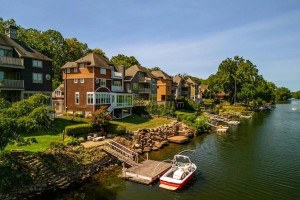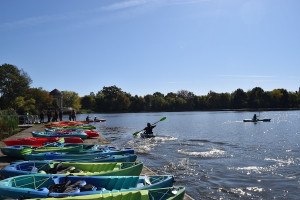Study: Philly’s ‘Burbs Would Be Stronger If They Walked the Walk Like Cities

The director of a national developers’ advocacy group argues that developments like Carl Dranoff’s planned One Ardmore Place are what suburban downtowns need to take advantage of a growing trend in favor of walkable urban places. | Image from Dranoff Properties via Destination Ardmore
One of the distinctive features of the metropolitan Philadelphia landscape is the high number of walkable Main Streets scattered throughout the suburbs. Ardmore, Bryn Mawr, Collingswood, Doylestown, Haddonfield, Jenkintown, Media, Narberth…the list goes on.
What we lack, apparently, is big-time walkable downtowns. We have only one of those, and it’s gathering all of the Millennial and Baby Boomer urbanites into its fold along with a good chunk of the new construction taking place around the region.
Places like these are what LOCUS calls “WalkUPs” — “walkable urban places.” LOCUS, an affiliate of Smart Growth America, is an advocacy group consisting of developers committed to producing more sustainable communities. Director Christopher Coes describes LOCUS as a “triple bottom line” organization: “Our developments should be a net positive for the environment and the local community” as well as for the developer, he said.
Besides advocating for practices and policies that promote more compact, walkable development that promotes both community interaction and multimodal transportation, LOCUS also supports research that demonstrates the economic benefits of such development. Two years ago, and again next month, a research study produced by the George Washington University with support from LOCUS assessed (and will reassess) the current level and extent of walkable regional centers and the potential for future ones to arise in the nation’s 30 largest metropolitan areas.
One statistic that might surprise Philadelphians, given how much we tout the walkability of both the city and many of its suburbs, is that the study, called “Foot Traffic Ahead,” put this area in the middle of the pack when it comes to walkable regional centers. This region placed 13th out of the 30 metros, with 17 “WalkUPs” accounting for 19 percent of the region’s total office and retail space; 95 percent of that walkable commercial real estate is located in the central city. For comparison purposes, 45 WalkUPs account for 43 percent of top-ranked Greater Washington’s office and retail space, and slightly over half of that pedestrian-oriented space is located in the suburbs.
The study also puts Philadelphia in the middle of the pack when it comes to the likelihood that it will develop more walkable regional centers in the future.
There have already been some small-scale efforts at turning what LOCUS calls “drivable sub-urban” regional centers into “walkable urban” ones in this region. The former Echelon Mall in Voorhees, for instance, was partially demolished and replaced with mixed-use residential, office and retail buildings arrayed along a pedestrian-scale street; to emphasize the former mall’s new role, Voorhees Township moved its offices into the new “Voorhees Town Center.” Right now, on the southern edge of Media, the Granite Run Mall is undergoing a similar demolition and makeover. Even builders of conventional auto-oriented, single-use retail centers pay lip service to the walkability principle in developments such as Main Street at Exton, which is slated to get a residential component in 2017.
Then there’s King of Prussia, home to the largest shopping mall in America as measured by total selling space and the largest employment center in the Philadelphia suburbs. The King of Prussia District has embarked on a project to transform parts of the car-centric edge city into more walkable places by narrowing thoroughfares, adding residences to shopping complexes, converting office buildings to mixed-use residential structures and adding a rail line that will connect almost all of the new developments to the mall, Norristown and Philadelphia.
King of Prussia District Executive Director Eric Goldstein said the moves are aimed squarely at Millennials and others who, while they might prefer suburban to urban living, nonetheless want some of that urban vibrancy close to home.
All of these transformations, says Coes, are rooted in the same larger trend away from the strictly use-segregated, drive-everywhere development pattern that has characterized American suburbia since the 1950s.
“Anyone who is in the regional mall business knows there hasn’t been a new mall opened since 2006 in the drivable sub-urban context,” he said. “Regional malls are dying.” And those that aren’t, like King of Prussia and the malls at Tysons Corner in Virginia, still realize they must adapt to changing consumer preferences.
Tysons, the East Coast’s ur-edge city, has made great strides in injecting walkability and mixed uses into an auto-oriented landscape, and King of Prussia is now headed down that road. Coes noted that both Tysons and King of Prussia sit in the middle of a vast swath of affluence that helps keep both centers viable, and that in turn buys time to rethink their strategies for attracting and retaining business.
“Tysons is almost a twin of what’s happening in your community,” he said. “Places like Metro Center and the 14th Street corridor in DC and Pentagon City in Virginia were getting greater price premiums [for leased space] than the stores in their complex.” This in turn led Tysons property owners to do things like chip in for the cost of a Washington Metro extension through the district and rezone properties to encourage mixed uses and pedestrian improvements. “Driving 45 minutes, having [no place to walk around] when you get there, and driving back was not a model of a future for Tysons.
“And while the tea leaves are better for King of Prussia than for other regional malls, they still had to do something differently.”
Echoing Goldstein somewhat, Coes noted that “not every Boomer or Millennial wants to move into Manhattan or Downtown DC. But they do want some of that urban context. That’s what you’re seeing in King of Prussia, and that’s why they’re deploying that strategy now.”
Coes said that commercial space in walkable urban places commands a significant premium over similar space in drivable sub-urban ones. A survey the organization conducted of the Boston and Washington markets, along with the seven largest real estate markets in Michigan, found that office space in walkable districts commanded a 30 percent rent premium; for retail space, the premium was as high as 144 percent in some cases.
Which brings us to one of the reasons why Philadelphia ranked lower than one might expect on the prospects-for-future-walkable-development scale: as the most recent “State of Center City” report from the Center City District reported, the commercial space premium Center City commands over suburban locations is much smaller: just 4 percent. (The full report is available here.)
What that means is that developers aren’t rushing to create new walkable regional centers here, despite the presence of plenty of raw stock to serve as starters. While Coes said that many developers elsewhere are looking at locations like the railroad suburbs of Philadelphia’s Main Line as potential redevelopment sites, there’s little such interest being shown locally at present. In fact, a mixed-use residential/retail development proposed for one such downtown, Carl Dranoff’s One Ardmore Place, has been delayed by court challenges from a group of residents who believe the project is too large for the community. (The Destination Ardmore site has a timeline of the long-delayed project.)
But while some people in Ardmore may fear that more development will turn their community into another Bethesda, others welcome such development. And Coes argues that there’s a place for suburban downtowns like it as employment hubs in a more walkable future. In Washington, he said, “every month, 1,000 people move in. But also every month, 3,000 are leaving.” When it comes to businesses, “two-thirds of those leaving the city are mid-sized companies that can’t find room to expand. They’re looking at first- and second-tier suburbs along the MARC [commuter rail] line to relocate.” Philly’s Main Line railroad suburbs, he said, would do well to emulate those suburban Washington communities. Not only would increased commercial development be environmentally sensible, he said, it would be good for the municipal treasury, because pedestrian-oriented development produces greater tax revenues that can then go towards upkeep of municipal infrastructure. Such development could also ease congestion on the region’s highways by giving local residents more employment options close to where they live.
As Philadelphia remains a relatively slow-growth region overall, the pressure for creating more walkable regional centers may remain modest for the foreseeable future. An updated edition of the “Foot Traffic Ahead” study is scheduled for release at LOCUS’ National Leadership Summit next month in Boston. Will Philadelphia remain in the middle of the pack? We will find out then.


